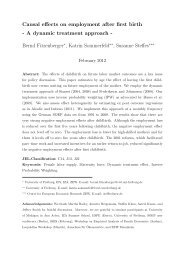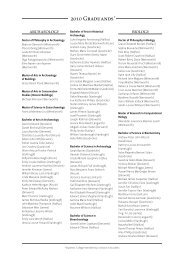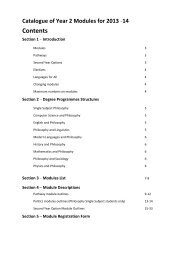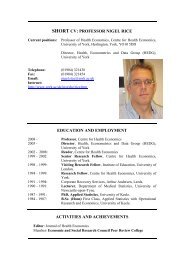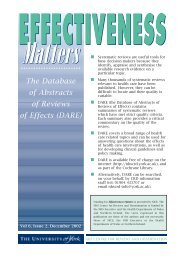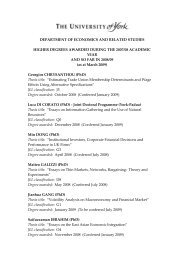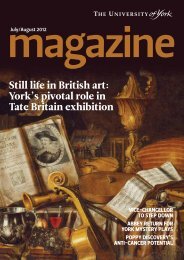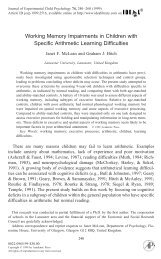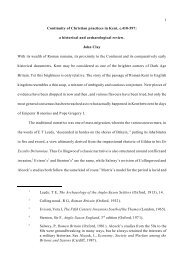GeloriniPhD (PDF , 6973kb) - University of York
GeloriniPhD (PDF , 6973kb) - University of York
GeloriniPhD (PDF , 6973kb) - University of York
Create successful ePaper yourself
Turn your PDF publications into a flip-book with our unique Google optimized e-Paper software.
Type HdV-1005: Brachydesmiella sp. (Plate I)<br />
. 49 .<br />
CHAPTER 1<br />
Diversity and ecology <strong>of</strong> tropical African fungal spores<br />
Conidia lemon-shaped, 2-septate, ca. 28-36 x 20 µm, the central cell large, the end cells small with thinner walls than<br />
central cell. The extant taxon B. biseptata was found on wood <strong>of</strong> deciduous trees in N-America and Europe (Ellis, 1971).<br />
Very rare in the Challa record; all 3 specimens occurred in two adjacent intervals about 20,500 cal. yr BP.<br />
Type HdV-1006 (Plate I)<br />
Fungal spores one-septate, ca. 25 x 10 µm, elliptic-cylindrical, one cell slightly broader than the other one. Apices have<br />
thicker walls, darker than central part. Rare in the Challa record (5 specimens total); present only in Glacial-period<br />
deposits.<br />
Type HdV-1007 (Plate I; Fig. 1.2)<br />
Fungal spores (conidia?) 3-septate, ca. 24-30 x 8-10 µm, constriction at central septum well developed, the other two<br />
septa not closed, with less constriction. Apical cells showing hilum. Type HdV-1007 spores were only recorded in the<br />
Glacial and Late-Glacial sections <strong>of</strong> the Challa record, disappearing from ca. 11,000 cal. yr BP.<br />
Type HdV-1008: cf. Valsaria sp. (Plate I)<br />
Ascospores uniseptate, ca. 30 x 20 µm, thick verrucose wall, septum very pronounced and slightly protruding. Fossil<br />
Valsaria type ascospores were recorded by van Geel et al. (2003) in soil samples from a Roman Period settlement site<br />
in the Netherlands. In the Challa record Type 1008 spores are relatively rare, but with a distinct Glacial and Late-Glacial<br />
distribution: 14 specimens were found in 7 intervals older than 11,100 cal. yr BP.<br />
Type HdV-1009: Chaetomium sp. (Plate I)<br />
Ascospores lemon-shaped, ca. 8-10 x 7-8 µm, bilaterally flattened with apical pores. Chaetomium species are cellulosedecomposing<br />
fungi occurring on plant remains and dung. Apart from the occurrence <strong>of</strong> their fossil ascospores in deposits<br />
from natural habitats (Type HdV-7A; van Geel, 1978; van Geel et al., 1989), fossil Chaetomium spores also appeared to be<br />
linked to archaeological sites (Buurman et al., 1995; van Geel et al., 2003). In the Challa record Chaetomium spores are<br />
very rare; we recovered 5 specimens in sediments dated between 18,200 and 7,700 cal. yr BP.<br />
Type HdV-1010 (Plate I; Fig. 1.2)<br />
Fungal spores uniseptate, fusiform, ca. 32 x 11 µm, with a pore at one end.<br />
Type HdV-1010 spores regularly occur in the Glacial and Late-Glacial sections <strong>of</strong> the Challa record but are largely absent<br />
in the Holocene, with the exception <strong>of</strong> a few finds at ca. 1300 and 400-300 cal. yr BP.<br />
Type HdV-1011: Epicoccum purpurascens Ehrenb. (Plate I; Fig. 1.2)<br />
The conidia <strong>of</strong> Epicoccum purpurascens are globose, 15-28 µm in diameter, verrucose, with multiple transverse and<br />
vertical septa and a funnel-shaped smooth base with attachment scar. E. purpurascens is a ubiquitous saprophytic fungus<br />
found on a variety <strong>of</strong> substrates. It is an extremely common cosmopolitan invader <strong>of</strong> dead plant material (Ellis, 1971),<br />
but is also known from soil, litter, wheat, potato, sugar beet, hay, bird nests, pulp, paper, cotton and wood (Domsch et al.,



